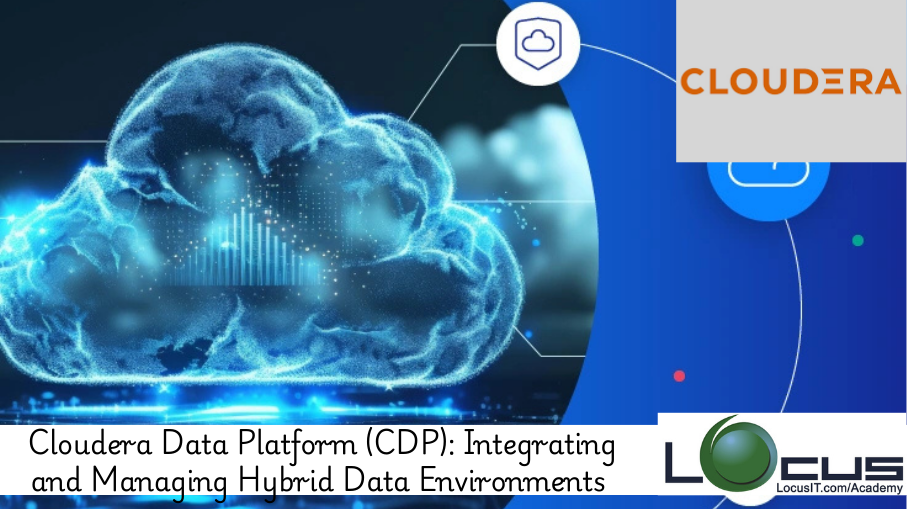Description
Introduction of Cloudera Data Platform(CDP)
Cloudera Data Platform (CDP) provides a unified platform that allows organizations to manage and analyze data across on-premises and cloud environments. It is designed to help businesses scale their data processing and analytics capabilities while integrating hybrid cloud architectures seamlessly. This course will explore the core components of CDP, focusing on how to integrate data from different sources, manage workloads across hybrid environments, and leverage the advanced features of CDP for better data governance, security, and efficiency. By the end of the course, you will be able to manage and optimize hybrid data environments using CDP, ensuring smooth data integration and operation.
Prerequisites
- Basic understanding of big data concepts and technologies like Hadoop.
- Familiarity with Cloudera products, such as Cloudera Manager or CDH, is beneficial but not required.
- Understanding of cloud computing, including public and private cloud platforms.
- Basic knowledge of SQL and distributed data systems.
Table of Contents
- Introduction to Cloudera Data Platform (CDP)
1.1 Overview of CDP and Hybrid Data Environments
1.2 Components of Cloudera Data Platform (CDP)
1.3 Key Benefits of Using CDP for Hybrid Data Integration
1.4 Cloud and On-Premises Integration in CDP
1.5 Use Cases and Applications of CDP - Setting Up and Configuring Cloudera Data Platform(CDP)
2.1 Installing and Configuring CDP for Hybrid Environments
2.2 Understanding CDP Control Plane vs. Data Plane
2.3 Setting Up Clusters Across Cloud and On-Premises
2.4 Managing Data and Workloads in a Hybrid Environment
2.5 Troubleshooting Common Installation and Configuration Issues - Data Integration Across Hybrid Environments
3.1 Overview of Data Integration in CDP
3.2 Connecting On-Premises and Cloud Data Sources
3.3 Migrating Data Between On-Premises and Cloud Environments
3.4 Real-Time Data Integration and Streaming with CDP
3.5 Integrating External Data with CDP (e.g., External Databases, APIs) - Managing and Orchestrating Data Pipelines
4.1 Introduction to Data Pipelines in CDP
4.2 Using CDP Data Engineering for Pipeline Creation
4.3 Orchestrating Hybrid Data Workflows
4.4 Leveraging Apache NiFi for Data Flow Management
4.5 Monitoring and Managing Data Pipelines in a Hybrid Environment - Data Governance and Security in Hybrid Environments
5.1 Implementing Data Governance with CDP
5.2 Managing Metadata with Apache Atlas
5.3 Security Models for Hybrid Data Environments
5.4 Data Encryption, Auditing, and Access Control
5.5 Compliance and Regulatory Considerations in Hybrid Data Environments - Optimizing Data Storage and Processing in Hybrid Environments
6.1 Storage Options in CDP: HDFS, Cloud Storage, and Data Lakes
6.2 Data Tiering and Archiving Strategies
6.3 Optimizing Data Processing with CDP (Batch vs. Real-Time)
6.4 Managing Data Partitioning and Clustering for Performance
6.5 Cost Management in Hybrid Data Storage - Deploying and Managing Machine Learning Workloads in CDP
7.1 Overview of Machine Learning and Data Science in CDP
7.2 Managing ML Workloads Across Cloud and On-Premises
7.3 Integrating Apache Spark and TensorFlow in Hybrid Environments
7.4 Using CDP for Data Science Collaboration
7.5 Performance Tuning for ML Workloads in Hybrid Clouds - Monitoring and Troubleshooting Hybrid Data Environments
8.1 Introduction to Monitoring Tools in CDP
8.2 Using Cloudera Manager for Hybrid Cloud Monitoring
8.3 Monitoring Data Flow, Performance, and Latency
8.4 Troubleshooting Connectivity Issues Between On-Premises and Cloud
8.5 Analyzing Logs and Metrics for Proactive Issue Resolution - Scaling Hybrid Data Environments with CDP
9.1 Scaling CDP Clusters for Hybrid Environments
9.2 Managing Data at Scale with CDP’s Autoscaling Capabilities
9.3 Best Practices for High Availability and Fault Tolerance
9.4 Load Balancing Across Hybrid Environments
9.5 Disaster Recovery Planning in Hybrid CDP Environments - Advanced Features of CDP for Hybrid Environments
10.1 Leveraging CDP for Cloud-Native Big Data Architectures
10.2 Integrating with Data Lakes and Cloud Data Warehouses
10.3 Hybrid Cloud Analytics with Apache Hive and Impala
10.4 Enhancing Data Security with AI-Powered Threat Detection
10.5 Future Trends and Developments in Hybrid Data Management - Best Practices for Managing Hybrid Data Environments
11.1 Best Practices for Hybrid Cloud Data Integration
11.2 Optimizing Resource Management Across Cloud and On-Premises
11.3 Implementing Efficient Data Governance and Security Models
11.4 Automation and Scripting for Data Operations
11.5 Maintaining Compliance and Standards in Hybrid Environments - Case Studies and Real-World Applications of CDP in Hybrid Environments
12.1 Case Study: Retail Industry Hybrid Data Management
12.2 Real-World Hybrid Data Architecture in Financial Services
12.3 Healthcare and Life Sciences: Managing Sensitive Data in the Cloud
12.4 Hybrid Cloud Data Solutions for Manufacturing and IoT
12.5 Data Integration Across Multiple Cloud Providers - Preparing for CDP Certifications and Career Advancement
13.1 Overview of Cloudera Certifications for Hybrid Data Environments
13.2 Resources for Preparing for Cloudera Certified Professional (CCP) Exams
13.3 How Hybrid Cloud Expertise Translates to Career Growth
13.4 Continuing Education and Advanced Certifications in CDP
13.5 Leveraging Networking and Community Resources for Professional Development
Conclusion of Cloudera Data Platform(CDP)
By completing this course, you will gain an in-depth understanding of how to integrate and manage data across hybrid environments using Cloudera Data Platform (CDP). You will learn how to connect on-premises and cloud data sources, orchestrate data workflows, ensure robust data governance and security, and leverage CDP’s tools for machine learning and big data analytics. Additionally, you will be able to apply best practices to optimize hybrid cloud environments, improve performance, and ensure compliance. With the knowledge gained, you will be well-prepared to handle complex hybrid data environments and drive data-driven initiatives across your organization.







Reviews
There are no reviews yet.